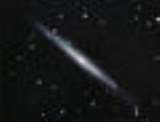
NGC 4244
Encyclopedia
NGC 4244, also Caldwell 26, is an edge-on loose Spiral galaxy
and Caldwell object
in the constellation Canes Venatici
. It is part of the M94 Group
(the Canes Venatici I Group), a galaxy group
relatively close to the Local Group
containing the Milky Way
. It shines at magnitude +10.2/+10.6. Its celestial cooridinates are RA , dec . It is located near a naked-eye G-class star Beta Canum Venaticorum, barred spiral galaxy
NGC 4151
, and irregular galaxy
NGC 4214
. The galaxy lies approximately 6.5 million/14 million light years away, with a redshift of +243/493 km/s. A nuclear star cluster
and halo is located at the centre of this galaxy.
Spiral galaxy
A spiral galaxy is a certain kind of galaxy originally described by Edwin Hubble in his 1936 work The Realm of the Nebulae and, as such, forms part of the Hubble sequence. Spiral galaxies consist of a flat, rotating disk containing stars, gas and dust, and a central concentration of stars known as...
and Caldwell object
Caldwell catalogue
The Caldwell Catalogue is an astronomical catalog of 109 bright star clusters, nebulae, and galaxies for observation by amateur astronomers. The list was compiled by Sir Patrick Caldwell-Moore, better known as Patrick Moore, as a complement to the Messier Catalogue.The Messier Catalogue is used...
in the constellation Canes Venatici
Canes Venatici
Canes Venatici is one of the 88 official modern constellations. It is a small northern constellation that was created by Johannes Hevelius in the 17th century. Its name is Latin for "hunting dogs", and the constellation is often depicted in illustrations as representing the dogs of Boötes the...
. It is part of the M94 Group
M94 Group
The M94 Group is a loose, extended group of galaxies located about 13 million light-years away in the constellations Canes Venatici and Coma Berenices. The group is one of many groups that lies within the Virgo Supercluster The M94 Group (Canes Venatici I Group) is a loose, extended group of...
(the Canes Venatici I Group), a galaxy group
Galaxy groups and clusters
Galaxy groups and clusters are the largest known gravitationally bound objects to have arisen thus far in the process of cosmic structure formation. They form the densest part of the large scale structure of the universe...
relatively close to the Local Group
Local Group
The Local Group is the group of galaxies that includes Earth's galaxy, the Milky Way. The group comprises more than 30 galaxies , with its gravitational center located somewhere between the Milky Way and the Andromeda Galaxy...
containing the Milky Way
Milky Way
The Milky Way is the galaxy that contains the Solar System. This name derives from its appearance as a dim un-resolved "milky" glowing band arching across the night sky...
. It shines at magnitude +10.2/+10.6. Its celestial cooridinates are RA , dec . It is located near a naked-eye G-class star Beta Canum Venaticorum, barred spiral galaxy
Barred spiral galaxy
A barred spiral galaxy is a spiral galaxy with a central bar-shaped structure composed of stars. Bars are found in approximately two-thirds of all spiral galaxies...
NGC 4151
NGC 4151
NGC 4151 is an intermediate spiral Seyfert galaxy located 43 million light years from Earth in the constellation Canes Venatici, discovered by Frederick William Herschel on March 17, 1787...
, and irregular galaxy
Irregular galaxy
An irregular galaxy is a galaxy that does not have a distinct regular shape, like a spiral or an elliptical galaxy. The shape of an irregular galaxy is uncommon – they do not fall into any of the regular classes of the Hubble sequence, and they are often chaotic in appearance, with neither a...
NGC 4214
NGC 4214
NGC 4214 is a dwarf barred irregular galaxy located around 10 million light-years away in the constellation Canes Venatici.-External links:* * ESA/Hubble Photo Release...
. The galaxy lies approximately 6.5 million/14 million light years away, with a redshift of +243/493 km/s. A nuclear star cluster
Star cluster
Star clusters or star clouds are groups of stars. Two types of star clusters can be distinguished: globular clusters are tight groups of hundreds of thousands of very old stars which are gravitationally bound, while open clusters, more loosely clustered groups of stars, generally contain less than...
and halo is located at the centre of this galaxy.

